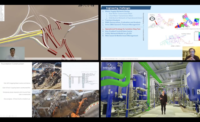Design and construction software/hardware provider Trimble Inc. is bundling together a suite of its digital products under the name Trimble Unity, intended to provide infrastructure owners with a single system that can handle data from a project’s planning and construction and through its operational lifecycle.
The Trimble Unity subscription includes Trimble Unity Construct, which is based on the construction management software of e-Builder, which Trimble acquired in 2018; Trimble Unity Maintain, an enterprise asset management system which uses elements of AgileAssets, Cityworks and Unity Work Management; Trimble Unity Permit, a permitting and licensing tool which runs through Cityworks; and Trimble Connect, which serves as a connected data environment. Trimble announced the new offering at its Innovate User Conference held May 14-16 in Cleveland.
The suite also includes a mobile application, Trimble Unity Field, which can be used for a variety of roles through construction of a new asset or inspections and maintenance of an existing one. Users can access project documents, visuals, assignments and other information. Everything can be tagged with GIS data to help quickly identify the location of work, service requests and inspections, and the app works offline.
The idea behind the suite is to save asset owners time and money through infrastructure’s operations and maintenance, which on average accounts for 75% of an asset’s cost, according to Cyndee Hoagland, senior vice president of Trimble’s owner and public sector business. She claims owners can save up to 40% on total asset costs by implementing a connected asset lifecycle management strategy.
“The suite is designed to harness the power of connection, facilitating data sharing and collaboration,” Hoagland says.
Unity is designed to make greater use of GIS technology than earlier offerings, according to Trimble. Unity Maintain includes a Linear Referencing System built with Esri ArcGIS Roads and Highways. Trimble has also added native support for GIS in e-Builder.
Unity also features greater connectivity between its different applications in order to allow information to move between them without tedious data re-entry. Chris Bell, vice president of industry strategy and portfolio marketing at Trimble, says the company is trying to solve the problem of the gap between handoff and operations. Rather than having staff spend hours inputting data from thousands of drawings, text files and other documents into a spreadsheet, Bell says that information can be captured during design and construction and retained for later in the same platforms that will be used for managing maintenance. And that information can be available across departments, rather than having different pieces siloed by different teams.
Trimble has already been working with some clients on implementing these kinds of systems. El Paso County, Colo., is transitioning from a project-centric process to an asset-centric one. Hoagland says the county has been able to use interoperability between Trimble platforms to streamline communication around projects to its construction services teams. County public works staff at the conference said it had been particularly helpful with a large paving contract with work performed in 130 locations by a single contractor. Work orders move from Cityworks to e-Builder for the project team. Then Cityworks is updated with information from e-Builder about the completed work, costs and other details.
“Asset owners have systems to design and build stuff, and computerized maintenance management software,” Bell says. “But the handoffs between those phases is so inefficient that an organization, [like a] public agency, would struggle to get the value if these things didn’t come together from a technological perspective.”






Post a comment to this article
Report Abusive Comment